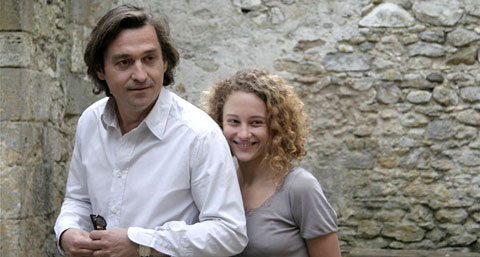Antichrist (Tars von Trier)
When asked at TIFF what I thought of Antichrist, I got in the habit of saying, “Well, it’s a testament to von Trier’s talent that he can make such an unremarkable film of such remarkable imagination and control.” It’s a genre film, right? A psychological horror movie with a few unexpected plot twists? I enjoyed it on that level, and I was amused, also, by its ostentatious wanderings into psychoanalysis-bashing, the history of gynocide, and bizarro-world astronomy, all of which beg pedantic interpretation. But I can’t seem to muster much energy for it myself. The most compelling defense of the film I’ve read is from Victor Morton, who sees it as a “raw production of von Trier’s inner depressive state.” There’s a strange and irresistible grandeur to von Trier’s images — the way he warps nature with a slow pan of his camera, for example, or that signature shot of arms reaching through the knotted roots of a tree. The actual experience of watching the film is more interesting and complicated than any of its rabbit-hole provocations. Having never suffered through it myself, I can’t speak to whether or not Antichrist accurately evokes, a la classic Surrealism, the true terrors and violence of depression (regrettably, I can vouch for Punch-Drunk Love‘s anxiety attacks), but the film certainly has an uncommon tenor that I found both exciting (as a cinephile) and despairing.
Independencia (Raya Martin)
Southeast Asian film programmer Raymond Phathanavirangoon dedicated the screening of Independencia to Alexis and Nika, which almost surely deepened my affection for it. Shot entirely on soundstages and with obviously-painted backdrops, the film alludes to a curious collection of precedents — early cinema, melodrama, newsreels, popular theater, the avant-garde (particularly Brakhage’s film scratching), and who knows how many Filipino influences that were lost on me. But I was most often reminded of wax figure museum displays of the sort one finds at national parks and tourist-friendly historic districts. Decades-old, dust-covered mannequins costumed as heroic leaders and noble savages, they recite, again and again and again, some story about our shared history, told from whatever enlightened perspective was en vogue at the moment of the display’s dedication. I’m not sure how much credit to give the politics of Independencia‘s content, but its form strikes me as being something quite original and potent (despite the many idle comparisons to Guy Maddin I keep reading), as if the wax figures were suddenly coming to life and confronting museum patrons who are in search of simple and comforting self-justifications.
Women Without Men (Shirin Neshat)
There’s much to like in Women Without Men, visual artist Shirin Neshat’s first feature. Like another, better TIFF film, João Pedro Rodrigues’s To Die Like a Man, it’s a work of magical realism that imagines an Edenic space where oppressive social and political forces are kept at bay — temporarily, at least. I have a weakness for stories like this one, which concerns four women: 30-something Munis, who lives at home with her domineering brother and spends her days crouched beside the console radio, hungry for news of the coup that would soon install the Shah; her friend Mahdokht, who lives in disgrace after being raped; Zarin, an anorexic-looking prostitute (played by Orsolya Tóth from Kornél Mundruczó’s Delta); and Farrokhlaqa, the bored, cultured wife of a wealthy officer. Each is drawn to a small orchard outside of Tehran, an idealized sanctuary where they are allowed a brief respite from their suffering, and where, under Farrokhlaqa’s influence, they have parties, discuss art, and sing secular songs. Neshat has a nice eye for composition, although much of the film feels familiar, like we’ve seen these shots and met these women in other Iranian films. The shock of what is new in Women Without Men, the female nudity and frank treatment of sexuality, seemed less radical when I learned afterwards that Neshat has spent her adult life in the States and that she had made her film outside of Iran and with some non-Iranian actresses.
Le Père de mes enfants (Mia Hansen-Løve)
Hansen-Løve didn’t make it to Toronto, but her producer introduced the film by saying it was loosely inspired by a once-prominent member of the French film industry. It was only at the midpoint of the film, after the main character Grégoire (Louis-Do de Lencquesaing) puts a bullet through his brain, that I realized he was standing in for Humbert Balsan, who committed suicide in 2005 after producing nearly 70 films, including Claire Denis’s L’Intrus, Lars von Trier’s Manderlay, and Bela Tarr’s The Man from London. Generally, I enjoy films that break in two, but in the case of Le Père de mes enfants, the two halves are a bit out of balance, owing mostly to de Lencquesaing’s charismatic performance. Perhaps it’s inevitable that a film about the death of a good husband and father will feel his loss: there’s a narrative and emotional void in the second act that Hansen-Løve can’t quite overcome, despite another impressive turn from Alice de Lencquesaing (also memorable in a similar role in Assayas’s Summer Hours). All the best parts of Le Père de mes enfants (and they’re very good) are the small gestures — the way Grégoire kisses his younger daughter’s hand when she reaches for him from the back seat of the car or the scene in which he patiently explains the history of the ancient church they tour together. Liquidating the foundered production company, which is the main focus of the second half of the film, seems so irrelevant by comparison. And maybe that’s the point.
Let Each One Go Where He May (Ben Russell)
I hope, eventually, to write at length about this film, one of the best I saw at the festival. In the meantime, read Michael Sicinski’s essay, “The Unbroken Path: Ben Russell’s Let Each One Go Where He May.” It’s fantastic.




